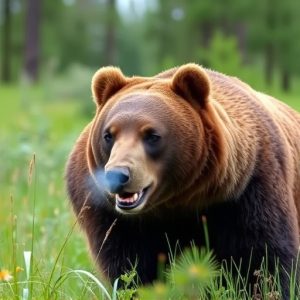Mastering Alaska’s Bear Spray Fog Pattern Test for Optimal Safety
The Bear Spray Fog Pattern Test is a crucial assessment for bear spray performance, replicating real…….
The Bear Spray Fog Pattern Test is a crucial assessment for bear spray performance, replicating real encounters to guide improvements in product design and user education. Conducted in controlled conditions with specific criteria, it evaluates spray distribution, coverage, and duration against grizzly and black bears. Successful tests create a dense cloud that disorients and deters bears, allowing users to implement enhanced safety measures when hiking or camping in bear country, based on observed spray pattern and technique adjustments.
In Alaska’s diverse wilderness, understanding bear spray fog pattern tests is paramount for outdoor enthusiasts and residents alike. This comprehensive guide explores the science behind bear spray performance, focusing on the crucial Bear Spray Fog Pattern Test. We delve into key components of successful testing, interpret results for optimal safety, and share best practices for responsible use in Alaska’s unique environment. By understanding these factors, you’ll be better equipped to navigate potential bear encounters with confidence and safety.
- Understanding Bear Spray Fog Pattern Test
- Key Components of a Successful Test
- Interpreting Results and Ensuring Safety
- Best Practices for Using Bear Spray in Alaska
Understanding Bear Spray Fog Pattern Test
The Bear Spray Fog Pattern Test is a crucial component in understanding how bear spray performs in real-world scenarios. This test simulates a typical bear encounter, where the spray is released into the air and its pattern is analyzed to determine its effectiveness at various distances and angles. By studying the fog pattern, experts can assess the spray’s range, coverage, and overall performance, ensuring it meets safety standards for those venturing into bear country.
This test provides valuable insights into the behavior of bear spray, especially in unpredictable wilderness environments. The results help manufacturers improve their products and educate users on proper usage techniques. Whether you’re a seasoned hiker or a novice camper, understanding the Bear Spray Fog Pattern Test can significantly enhance your safety measures when facing potential bear encounters.
Key Components of a Successful Test
When conducting a bear spray fog pattern test, several key components contribute to ensuring its success. Firstly, use a high-quality bear spray designed for maximum effectiveness against grizzly and black bears. The spray should be tested in controlled conditions mimicking real-world scenarios, including varying wind speeds and directions to accurately simulate deployment in the field.
Secondly, focus on evaluating the fog pattern’s reach and coverage. A successful test measures how far the spray projects and ensures it creates a dense enough cloud to deter aggressive bears. Additionally, assess the time duration of the fog, as a prolonged misting effect increases safety during encounters. Remember, the goal is to understand how well the bear spray performs in various conditions, allowing users to make informed decisions for personal safety in Alaska’s rugged terrain.
Interpreting Results and Ensuring Safety
Understanding the results of a bear spray fog pattern test is key to ensuring your safety in potential encounters. After conducting the test, carefully observe the spray distribution and pattern left on the target surface or dummy. Look for even coverage, ensuring that the spray reaches all areas where a bear might attack, including the face, body, and legs. A well-distributed fog pattern should create a dense cloud of spray, temporarily disorienting and deterring the bear.
Remember, the goal is to create a barrier between you and the bear, giving you time to retreat or defend yourself. If the test reveals any inconsistencies or gaps in coverage, adjust your application technique or consider using a different brand or type of bear spray. Regularly reviewing and practicing these tests will help ensure that you’re prepared for real-world situations, fostering a higher chance of safe navigation through bear country.
Best Practices for Using Bear Spray in Alaska
When using bear spray in Alaska, understanding the optimal fog pattern is crucial for maximum effectiveness during encounters. The ideal spray pattern should cover a wide area, aiming for a dense cloud that envelops both the frontal and lateral aspects of potential threat bears. This ensures that the spray reaches sensitive areas like the bear’s eyes, nose, and mouth, temporarily disabling it. Conducting the Bear Spray Fog Pattern Test is recommended to familiarize yourself with the spray’s range and dispersion before venturing into Alaska’s wilderness.
Best practices dictate a calm and deliberate approach when deploying bear spray. Keep your back against a barrier or secure structure for added safety. As you activate the spray, aim slightly upwards at an angle of approximately 30 degrees to account for wind drift, ensuring coverage across the expected path of potential bear movement. It’s important to remain still after spraying, allowing the fog to take effect and providing time for any bears to retreat or be contained within the fog cloud.
The Bear Spray Fog Pattern Test is a crucial tool for ensuring safety in Alaska’s wild landscapes. By understanding the key components and interpreting results accurately, individuals can make informed decisions while navigating potential bear encounters. Best practices emphasize responsible usage, emphasizing that bear spray is most effective when used correctly and in conjunction with other preventive measures. Remember, knowledge and preparation are vital to staying safe during outdoor activities in bear country.


